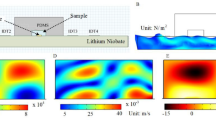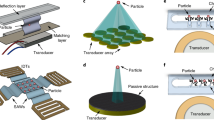Abstract
Sound wave-assisted acoustic micromixing has been shown to increase the binding of molecules in small volumes (10–100 μL) where effective mixing is difficult to achieve through conventional techniques. The aim of this work is to study whether acoustic micromixing can increase the binding efficiency of antibodies to their antigens, a reaction that forms the basis of immunoassays, including enzyme-linked immunosorbent assay (ELISA). Using a procedure from a general ELISA and immobilizing an antigen on wells of 96-well plates, it was found that acoustic micromixing at 125–150 Hz increased the initial rate of antibody-antigen binding by over 80 % and the total binding at the end point (i.e., 45 min) by over 50 %. As a result, acoustic micromixing achieved a binding level in 9 min that would otherwise take 45 min on a standard platform rocking mixer. Therefore acoustic micromixing has the potential to increase the detection sensitivity of ELISA as well as shorten the antigen-antibody binding times from typically 45–60 min to 15 min.




Similar content being viewed by others
References
B. Acevedo, Y. Perera, M. Ruiz, G. Rojas, J. Benitez, M. Ayala, J. Gavilondo, Development and validation of a quantitative ELISA for the measurement of PSA concentration. Clin. Chim. Acta 317(1–2), 55–63 (2002)
D. Ahmed, X. Mao, B.K. Juluri, T.J. Huang, A fast microfluidic mixer based on acoustically driven sidewall-trapped microbubbles. Microfluid. Nanofluid. 7(5), 727–731 (2009)
W.C. Boon, K. Petkovic-Duran, K. White, E. Tucker, A. Albiston, R. Manasseh, M.K. Horne, T.D. Aumann, Acoustic microstreaming increases the efficiency of reverse transcription reactions comprising single-cell quantities of RNA. Biotechniques 50(2), 116–119 (2011a)
W.C. Boon, K. Petkovic-Duran, Y. Zhu, R. Manasseh, MK. Horne, and Aumann TD. Increasing cDNA yields from single-cell quantities of mRNA in standard laboratory reverse transcriptase reactions using acoustic microstreaming. J. Vis. Exp.: JoVE(53):e3144–e3144 (2011b)
O. Ducloux, E. Galopin, F. Zoueshtiagh, A. Merlen, V. Thomy, Enhancement of biosensing performance in a droplet-based bioreactor by in situ microstreaming. Biomicrofluidics 4(1), 11102 (2010)
E. Engvall, P. Perlmann, Enzyme-linked immunosorbent assay (ELISA) quantitative assay of immunoglobulin-G. Immunochemistry 8(9), 871–874 (1971)
Y.Z. Fu, R. Yuan, Y.Q. Chai, L. Zhou, Y. Zhang, Coupling of a reagentless electrochemical DNA biosensor with conducting polymer film and nanocomposite as matrices for the detection of the Hiv DNA sequences. Anal. Lett. 39(3), 467–482 (2006)
E. Galopin, M. Beaugeois, B. Pinchemel, J.-C. Camart, M.B. Ouazaoui, V. Thomy, SPR biosensing coupled to a digital microfluidic microstreaming system. Biosens. Bioelectron. 23(5), 746–750 (2007)
J.F.T. Griffin, E. Spittle, C.R. Rodgers, S. Liggett, M. Cooper, D. Bakker, J.P. Bannantine, Immunoglobulin G1 enzyme-linked immunosorbent assay for diagnosis of Johne’s disease in red deer (Cervus elaphus). Clin. Diagn. Lab. Immunol. 12(12), 1401–1409 (2005)
V. Hessel, H. Lowe, F. Schonfeld, Micromixers - a review on passive and active mixing principles. Chem. Eng. Sci. 60(8–9), 2479–2501 (2005)
G.S. Jeong, S. Chung, C.-B. Kim, S.-H. Lee, Applications of micromixing technology. Analyst 135(3), 460–473 (2010)
K. Kourentzi, M. Srinivasan, S.J. Smith-Gill, R.C. Willson, Conformational flexibility and kinetic complexity in antibody-antigen interaction. J. Mol. Recognit. 21(2), 114–121 (2008)
S.X. Leng, J.E. McElhaney, J.D. Walston, D. Xie, N.S. Fedarko, G.A. Kuchel, ELISA and multiplex technologies for cytokine measurement in inflammation and aging research. J. Gerontol. Ser. Biol. Sci. Med. Sci. 63(8), 879–884 (2008)
R.M. Lequin, Enzyme Immunoassay (EIA)/Enzyme-Linked Immunosorbent Assay (ELISA). Clin. Chem. 51(12), 2415–2418 (2005)
M.A. Levesque, H. Yu, G.M. Clark, E.P. Diamandis, Enzyme-linked immunoabsorbent assay-detected p53 protein accumulation: A prognostic factor in a large breast cancer cohort. J. Clin. Oncol. 16(8), 2641–2650 (1998)
C.A. Lipschultz, A. Yee, S. Mohan, Y.L. Li, S.J. Smith-Gill, Temperature differentially affects encounter and docking thermodynamics of antibody-antigen association. J. Mol. Recognit. 15(1), 44–52 (2002)
R.H. Liu, R. Lenigk, R.L. Druyor-Sanchez, J.N. Yang, P. Grodzinski, Hybridization enhancement using cavitation microstreaming. Anal. Chem. 75(8), 1911–1917 (2003a)
R.H. Liu, R. Lenigk, P. Grodzinski, Acoustic micromixer for enhancement of DNA biochip systems. J. Microlithogr. Microfabric. Microsyst. 2(3), 178–184 (2003b)
H. Nygren, M. Werthen, M. Stenberg, Kinetics of antibody-binding to solid-phase-immobilized antigen-effect of diffusion rate limitation and steric interaction. J. Immunol. Methods 101(1), 63–71 (1987)
K. Petkovic-Duran, R. Manasseh, Y. Zhu, A. Ooi, Chaotic micromixing in open wells using audio-frequency acoustic microstreaming. Biotechniques 47(4), 827–831 (2009)
A. Renaudin, V. Chabot, E. Grondin, V. Aimez, and P.G. Charette. Accelerated binding kinetics by surface acoustic waves (SAW) micromixing in surface plasmon resonance (SPR) system for biodetection. Microfluidics Biomems Med. Microsyst. Ix 7929 (2011)
R.D. Soltis, D. Hasz, Studies on the nature of intermolecular bonding in antigen-antibody complexes. Immunology 46(1), 175–181 (1982)
M. Stenberg, H. Nygren, Kinetics of antigen-antibody reactions at solid-liquid interfaces. J. Immunol. Methods 113(1), 3–15 (1988)
M.G. Taylor, A. Rajpal, J.F. Kirsch, Kinetic epitope mapping of the chicken lysozyme center dot HyHEL-10 Fab complex: delineation of docking trajectories. Protein Sci. 7(9), 1857–1867 (1998)
C.J. Vanoss, R.J. Good, M.K. Chaudhury, Nature of the antigen-antibody interaction-primary and secondary bonds-optimal conditions for association and dissociation. J. Chromatogr. 376, 111–119 (1986)
Acknowledgments
The authors would like to thank CSIRO Manufacturing Flagship for funding this research.
Compliance with Ethical Standards
ᅟ
Conflicts of Interest
No potential conflicts of interest
Research involving Human Participants and/or Animals
Not applicable because no human or animal participants are involved in the study.
Informed consent
Not applicable because no human participants are involved in the study.
Author information
Authors and Affiliations
Corresponding authors
Rights and permissions
About this article
Cite this article
Gao, Y., Tran, P., Petkovic-Duran, K. et al. Acoustic micromixing increases antibody-antigen binding in immunoassays. Biomed Microdevices 17, 79 (2015). https://doi.org/10.1007/s10544-015-9987-0
Published:
DOI: https://doi.org/10.1007/s10544-015-9987-0




